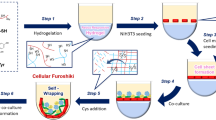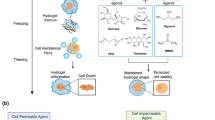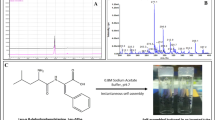Abstract
Recent advances in the bioengineering field have introduced new opportunities enabling cell encapsulation in three-dimensional (3D) structures using either various natural or synthetic materials. However, such hydrogel scaffolds have not been fully biocompatible for cell cultivation due to the lack of physical stability or bioactivity. Here, we utilized a uniquely fabricated semi-synthetic 3D polyethylene glycol-fibrinogen (PEG-Fb) hydrogel scaffold, which exhibits both high stability and high bioactivity, to encapsulate HEK293 cells for the production of human recombinant acetylcholine esterase (AChE). To examine the beneficial bioactive effect of the PEG-Fb scaffold over 2D surfaces, an experimental system was established to compare the viability, proliferation and AChE secretion of encapsulated cells versus non-encapsulated surface-adherent cells in serum starvation. Our results show that the transfer of surface-adherent HEK293 cells from fully enriched medium with 10% FCS to 0.2% FCS resulted in an eightfold reduction in cell number and a fourfold reduction in AChE production. In contrast, the encapsulated cells were highly viable and about twofold more efficient in AChE production. In addition, they had round morphology with a twofold larger cell diameter, supporting the observation of increased AChE production. These results suggest a role of the PEG-Fb scaffold in providing a supportive microenvironment in reduced serum conditions that enhances encapsulated cell functions, opening new directions to study the implementation of this platform in large-scale pharmaceutical protein production.





Similar content being viewed by others
References
Abdeen SH, Abdeen AM, El-Enshasy HE, El Shereef AA (2011) HeLa-S3 cell growth conditions in serum-free medium and adaptability for proliferation in suspension culture. J Biol Sci 11:124–134
Almany L, Seliktar D (2005) Biosynthetic hydrogel scaffolds made from fibrinogen and polyethylene glycol for 3D cell cultures. Biomaterials 26:2467–2477
Barnes LM, Moy N, Dickson AJ (2006) Phenotypic variation during cloning procedures: analysis of the growth behavior of clonal cell lines. Biotechnol Bioeng 94:530–537
Barralet JE, Wang L, Lawson M, Triffitt JT, Cooper PR, Shelton RM (2005) Comparison of bone marrow cell growth on 2D and 3D alginate hydrogels. J Mater Sci Mater Med 16:515–519
Barrett PN, Mundt W, Kistner O, Howard MK (2009) Vero cell platform in vaccine production: moving towards cell culture-based viral vaccines. Expert Rev Vaccines 8:607–618
Berkovitch Y, Seliktar D (2017) Semi-synthetic hydrogel composition and stiffness regulate neuronal morphogenesis. Int J Pharm 25:545–555
Bryant SJ, Anseth KS (2002) Hydrogel properties influence ECM production by chondrocytes photoencapsulated in poly(ethylene glycol) hydrogels. J Biomed Mater Res 59:63–72
Butcher JT, Nerem RM (2004) Porcine aortic valve interstitial cells in three-dimensional culture: comparison of phenotype with aortic smooth muscle cells. J Heart Valve Dis 13:478–485
Dikovsky D, Bianco-Peled H, Seliktar D (2006) The effect of structural alterations of PEG-fibrinogen hydrogel scaffolds on 3-D cellular morphology and cellular migration. Biomaterials 27:1496–1506
Dumont J, Euwart D, Mei B, Estes S, Kshirsagar R (2016) Human cell lines for biopharmaceutical manufacturing: history, status, and future perspectives. Crit Rev Biotechnol 36:1110–1122
Ellman GL, Courtney KD, Andres VJ, Feather-Stone RM (1961) A new and rapid colorimetric determination of acetylcholinesterase activity. Biochem Pharmacol 7:88–95
Grachev V, Magrath D, Griffiths E (1998) WHO requirements for the use of animal cells as in vitro substrates for the production of biologicals (requirements for biological susbstances no. 50). Biologicals 26:175–193
Hu X, Xiao C, Huang Z, Guo Z, Zhang Z, Li Z (2000) Pilot production of u-PA with porous microcarrier cell culture. Cytotechnology 1–3:13–19
Kaufmann H, Mazur X, Fussenegger M, Bailey JE (1999) Influence of low temperature on productivity, proteome and protein phosphorylation of CHO cells. Biotechnol Bioeng 63:573–582
Kerscher P, Turnbull IC, Hodge AJ, Kim J, Seliktar D, Easley CJ, Costa KD, Lipke EA (2016) Direct hydrogel encapsulation of pluripotent stem cells enables ontomimetic differentiation and growth of engineered human heart tissues. Biomaterials 83:383–395
Kronman C, Velan B, Gozes Y, Leitner M, Flashner Y, Lazar A, Marcus D, Sery T, Papier Y, Grosfeld H, Cohen S, Shafferman A (1992) Production and secretion of high levels of recombinant human acetylcholinesterase in cultured cell lines: microheterogeneity of the catalytic subunit. Gene 121:295–304
Kumar A, Goel AS, Payne JK, Evans C, Mikolajczyk SD, Kuus-Reichel K, Saedi MS (1999) Large-scale propagation of recombinant adherent cells that secrete a stable form of human glandular kallikrein, hK2. Protein Expr Purif 15:62–68
Lloyd AC (2013) The regulation of cell size. Cell 154:1194–1205
Lloyd DR, Holmes P, Jackson LP, Emery AN, Al-Rubeai M (2000) Relationship between cell size, cell cycle and specific recombinant protein productivity. Cytotechnology 34:59–70
Martino MM, Briquez PS, Ranga A, Lutolf MP, Hubbell JA (2013) Heparin-binding domain of fibrin(ogen) binds growth factors and promotes tissue repair when incorporated within a synthetic matrix. Proc Natl Acad Sci USA 110:4563–4568
Plotkin M, Vaibavi SR, Rufaihah AJ, Nithya V, Wang J, Shachaf Y, Kofidis T, Seliktar D (2014) The effect of matrix stiffness of injectable hydrogels on the preservation of cardiac function after a heart attack. Biomaterials 35:1429–1438
Pradhan S, Clary JM, Seliktar D, Lipke EA (2016) A three-dimensional spheroidal cancer model based on PEG-fibrinogen hydrogel microspheres. Biomaterials 115:141–154
Sunstrom NA, Gay RD, Wong DC, Kitchen NA, DeBoer L, Gray PP (2000) Insulin-like growth factor-I and transferrin mediate growth and survival of Chinese hamster ovary cells. Biotechnol Prog 16:698–702
Wurm FM (2004) Production of recombinant protein therapeutics in cultivated mammalian cells. Nat Biotechnol 22:1393–1398
Author information
Authors and Affiliations
Corresponding author
Ethics declarations
Conflict of interest
The authors declare that they have no conflict of interest.
Rights and permissions
About this article
Cite this article
Cohen, N., Toister, E., Lati, Y. et al. Cell encapsulation utilizing PEG-fibrinogen hydrogel supports viability and enhances productivity under stress conditions. Cytotechnology 70, 1075–1083 (2018). https://doi.org/10.1007/s10616-018-0204-x
Received:
Accepted:
Published:
Issue Date:
DOI: https://doi.org/10.1007/s10616-018-0204-x




